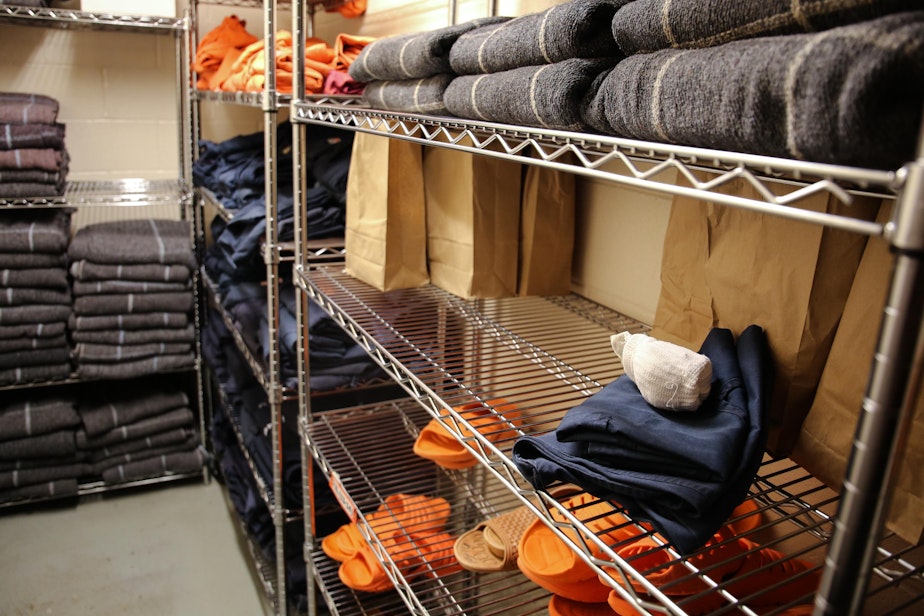Booked and buried: Northwest jails' mounting death toll

In 2012, Michael Saffioti, a 22-year-old with severe asthma and a dairy allergy, turned himself in on a misdemeanor marijuana possession charge. The next day at the Snohomish County Jail in Everett, Washington, he was served oatmeal that contained milk. Saffioti went into anaphylaxis and died.
In 2015, in Island County Jail on Washington’s Whidbey Island, 25-year-old Keaton Farris was found naked on the floor of his cell. He died malnourished and dehydrated after guards turned off the water to his cell because he had flooded it before.
One year later, in the Columbia County Jail in St. Helens, Oregon, two inmates attempted suicide on the same day. Responders saved one, but 44-year-old Jason Shaw later died at a Portland hospital. He had hanged himself using a bed sheet.
In 2018, 53-year-old Jacqueline Cowans was booked at the Lane County Jail in Eugene, Oregon, on three warrants: burglary, possession of a stolen vehicle and unlawful delivery of methadone. Eight days later she was moaning, asking for water and saying she was dying. Less than an hour after that, she was dead. The medical examiner determined she died from internal bleeding caused by pancreatitis.
Since 2008, at least 306 people across the Northwest have died after being taken to a county jail, according to an investigation by OPB, KUOW and the Northwest News Network. Until now, that number was unknown, in part because Oregon and Washington have not comprehensively tracked those deaths in county jails. Instead, state authorities leave detailed tracking to the federal government, which collects self-reported deaths from individual jails.
If states did track deaths, they would find a crisis of rising death rates in overburdened jails that have been set up to fail the inmates they are tasked with keeping safe.
***
About The Data
This analysis relied on death-in-custody reports filed with the federal government, requested from county jails in Oregon and Washington. This analysis excludes municipal and tribal jail facilities. Some counties provided full records, some provided redacted copies and some provided only basic information such as the number of deaths in a given year. Where possible, missing data was filled in using information from news reports, court filings, interviews and correspondence with law enforcement.
This dataset includes people who died behind bars and those who died after being taken from jail to health care facilities. It consists of both official “in-custody” death records and inmate deaths that did not meet that specific definition. The number of inmate deaths in this data is likely an undercount. Each county was given a list of jail deaths compiled for years 2008-2018 to review for accuracy. All but three counties responded.
This data collection represents an ongoing effort and will be updated. If you have additional information about jail deaths in Oregon or Washington, or if you wish to obtain a copy of the data, contact Tony Schick at aschick@opb.org.
***
State lawmakers who could improve funding, staff training or standards have taken little action. They say they are in the dark about how many people have even died in jail, let alone how to prevent those deaths.
As a result, jails' rising death tolls avoid the spotlight. And year after year, people die of suicides that could be prevented or medical conditions that should be treated.
“The lack of good national data and the lack of data even at the state level about what’s going on in local jails is really sort of striking and frightening,” said Nancy Fishman, project director for the Center on Sentencing and Corrections at the Vera Institute of Justice, a nonprofit that focuses on criminal justice issues. “Nobody even within the county — in most places — has any idea who’s in the jail and how they got there.”
Annual Jail Mortality Rates
The best available data shows mortality rates, while varying year to year, have trended upward both in the region and across the country. Rates are based on deaths per 100,000 inmates*
Tony Schick, OPB. Source: Bureau of Justice Statistics, Oregon State Sheriffs Association, Washington Association of Sheriffs and Police Chiefs, Jail death records gathered from county jails. *A national rate has not been published since 2014. Oregon’s average daily jail population also was not available past 2014. It has been estimated here based on total bookings.
While deaths resulting from police shootings or violent arrests have become the focus of calls for criminal justice reform, the vast majority of jail deaths go unexamined. In 2018, police shot and killed 39 people between Oregon and Washington, according to data compiled by The Washington Post. For that same year, our investigation found 39 deaths in Oregon and Washington county jails.
At least 70 percent of Northwest inmates who died in the past decade were awaiting trial at the time of their deaths and still considered innocent under the law.
Suicide, by far the leading cause of jail deaths in the Pacific Northwest, accounted for nearly half of all cases with a known cause of death. Concerns surrounding local jail deaths, particularly suicides, have been documented since at least the 1980s.
Nevertheless, in-custody deaths have continued. In fact, over the past 10 years, the rate of jail deaths has trended upward in Oregon and Washington, according to an analysis of the data compiled by OPB, KUOW and the Northwest News Network. In 2008, county jails in Washington had a mortality rate of about 123 deaths for every 100,000 inmates. By 2017, that rate was 162.
Jail population data for 2018 aren’t yet available, but reported deaths spiked that year. A conservative estimate puts the 2018 mortality rate closer to 200 deaths per 100,000 inmates.
Comparable data in Oregon are not available past 2014, but the latest available figures also show an upward trend. Jail deaths in Oregon have increased compared to total bookings, state population and projections of daily jail populations.
“If we were seeing the numbers published of how many people are dying on a county-by-county basis, many more people would stand up and say it’s not acceptable,” said Nathan Roberts, an attorney for the Connelly Law Offices in Tacoma, where he’s worked on more than a dozen jail and prison death lawsuits over the past decade.
Counties voluntarily provide the federal Bureau of Justice Statistics detailed data on each in-custody death, but these reports are not readily available to the public. The bureau’s public reports examine only state and national trends, not individual jails. The scope, circumstances and details of Northwest jail deaths are not tracked and reported publicly by any agency.
Our investigation offers the first clear picture of county jail inmate deaths in Oregon and Washington. It includes people who died behind bars and those who died after being taken from jail to the hospital. It consists of both official “in-custody” death records and inmate deaths that did not meet that specific definition, identified through public records, interviews with county officials, attorneys and media reports.
While the database is the most comprehensive to date, it is likely an undercount because of underreporting by jail officials.

J
ails are the entry point to the criminal justice system. Anyone from an accused shoplifter to an alleged murderer could be booked into jail — not prison. Every year, approximately 440,000 people are booked into jails in Oregon and Washington. That spans 37 county jails in Washington, 29 in Oregon, and municipal and tribal jails in both states.
“Many more people will see the inside of a local jail than will ever see a state or federal prison cell. And so the reach into the community is much greater and the potential damage, quite frankly, is much greater,” Fishman said. “It’s really part of this creeping wave of mass incarceration at the local level that’s remarkably unscrutinized.”
County jails play an integral role in the criminal justice system. Yet those who run them say they’re outdated, underfunded and understaffed.
“[Jails are] very costly because we’re required to do so much for the individual. And to do it cheaply requires potentially cost savings and doing some things that may not be right,” said Capt. Michael Shults, the Deschutes County Jail commander who also spent 30 years working in Multnomah County Corrections. “Those are things we have to look out for to make sure we’re not putting our staff or the inmates in jeopardy.”
At the same time, jails are forced to handle communities’ most complex and vulnerable people, many of whom are in the throes of mental health crises, drug withdrawals or undiagnosed medical conditions.
“These facilities, they lack the medical staff that are trained to assess for these problems and to take care of these problems,” said Dr. Richard Cummins, a professor of medicine at the University of Washington who has served as an expert witness in jail death lawsuits.
Nights Spent In Jail For Deceased Inmates
More than 40 percent of deceased inmates spent less than a week in jail.
Tony Schick, OPB. Source: Jail death records gathered by OPB, Northwest News Network and KUOW.
OPB, KUOW and the Northwest News Network’s analysis found more than 40 percent of deaths happened within an inmate’s first week in jail. A third of all inmates never made it past three days.
Some deaths in county jails are outside the control of jail staff. Marin Fox, who runs the Cowlitz County Jail in southwest Washington, said the people coming through her doors are sicker, more likely to be mentally ill and more likely to be acutely drug addicted than when she started 20 years ago.
“I’m not saying there’s no responsibility in the jails, but I think there needs to be more blame and focus on the community and why these people are ending up in jail,” Fox said.

F
orty years ago, jail experts from around the country met in Minneapolis for the Second National Assembly on what they called at the time a “jail crisis.” A similar portrait emerged of local jails: operations tasked with difficult jobs they weren’t equipped to do.
"They have become institutions of last resort, warehouses of human failure, for many — alcoholics, the mentally ill or retarded — for whom society has found no other place," a 1978 report, The American Jail in Transition, states. “These proceedings are offered in the hope that they will stimulate reform at all levels of government … and that those who have the power to change the situation — legislators, judges, citizens, federal administrators — will be stirred to action.”
Total Deaths By Jail, Oregon and Washington
More than 40 percent of deceased inmates spent less than a week in jail.
Tony Schick, OPB. Source: U.S. Census Bureau, Oregon State Sheriffs Association, Washington Association of Sheriffs and Police Chiefs, staff reporting by OPB, Northwest News Network, KUOW.
Decades later, the same issues — even many of the same buildings — remain. Take, for instance, the 35-year-old Clark County Jail in Vancouver, Washington. During a recent tour, roughly 30 inmates were seen living in a minimum-security housing pod meant for just eight people.
In Oregon, jails are required to be inspected by county commissioners and grand juries. Jails must comply with a set of statewide standards that govern everything from riot control to a requirement that mattresses and blankets be fire-retardant. Jail leaders in the state inspect one another’s facilities and submit reports to the Oregon Department of Corrections. The state said it’s not aware of any action taken against any jail facility in the past 10 years.
Washington has no mandatory statewide jail standards or inspection programs. Instead, jails are required to develop their own standards to ensure the health, welfare and safety of inmates.
About three years ago, Washington state Rep. Roger Goodman, D-Kirkland, chair of the House Public Safety Committee, convened a workgroup to examine the state of jails in Washington. Goodman said the consensus from those meetings was that Washington should establish statewide standards. But, he said, it soon became apparent most counties could not afford to meet new standards without substantial help from the state.
“And so this is a question of the Legislature coming up with a considerable amount of money, which we say we don’t have,” Goodman said. “There are so many other competing priorities.”
Instead, Goodman said, lawmakers are now focused on shoring up the state’s community mental health system and expanding options to divert people in crisis away from jail. Separately, a task force in Washington has recommended increasing the number of people released from jail while awaiting trial. “Our priority right now is behavioral health and we will avert some of these disasters in jails and in the community by addressing behavioral health,” Goodman said.

J
ail deaths in both Oregon and Washington remain predictable occurrences. Between 20 and 40 county inmates in the Northwest die each year. Though not every Northwest jail has reported deaths in the past decade, several have had mortality rates higher than the last reported national average, which in 2014 was 140 deaths per 100,000 inmates.
Yet no agency or independent task force in either Oregon or Washington has done an analysis to determine why. Often, the only source of information about the deaths for families of those who die in jail comes by way of civil lawsuits.
“Every family I’ve ever worked for doesn’t really care about the money,” said Cheryl Snow, an attorney in Seattle who represented the family of Michael Saffioti, the 22-year-old who died after eating oatmeal in jail in 2012. “Their whole thing is they want to be left with the thought that this is not going to happen to somebody else’s child, or mother or brother.”
Saffioti’s family won a $2.4 million settlement against Snohomish County. Snow has since filed two more lawsuits on behalf of families whose loved ones died in the Snohomish County Jail.
Statisticians at the Bureau of Justice Statistics, which collects the data most researchers rely on, said 98 percent of jails last year responded to their request for data.
“We take what we can get,” said Ann Carson, acting chief of the corrections unit at the Bureau of Justice Statistics. “We rely on them to be truthful with us."
Government officials in many counties resisted the release of public information about deaths in jail, often citing privacy concerns or public records exemptions. In our search for records of inmate deaths from 66 counties in the Pacific Northwest, only one — King County, Washington — offered information on deaths that it tracks beyond what BJS collects.
Several counties disputed that certain deaths happened in their custody. In some cases, the deaths were never reported to the federal government. In another case, officials did report it but later claimed it should not be counted as a death in custody.
In 2013, Donnie Ray Brown died hours after he was released from the Coos County Jail. The county never reported his death to the federal government. Brown’s family sued, and a federal judge ruled the jail failed to fulfill its constitutional obligation to provide inmates adequate medical care.
“There was approximately a 50 minute delay in transporting Brown via courtesy ride [as opposed to ambulance] as deputies waited for him to be approved for early release and to change from his jail garb to his personal clothing, a task which was made more difficult because of his condition,” Judge Thomas Coffin wrote.
On Nov. 1, 2017, Jeffrey S. Jolibois died at the Harrison Medical Center in Bremerton, Washington. His official cause of death is listed as sepsis pneumonia.
Jolibois had been booked in February of that year. He spent more than 260 nights in jail. On Halloween, he was taken to the hospital. The county jail released him the next day, and he was dead by 1:20 p.m. that day.
“When he died, Mr. Jolibois was not an inmate in the Kitsap County Jail,” the county later told reporters.
On May 21, 2018, in Spokane, Washington, Patrick Flynn died at the age of 36. He had been an inmate of the Spokane County Jail.
“He was not an in-custody death,” according to county officials.
Flynn hanged himself with a bedsheet anchored to the bed of his jail cell.
The jail released him from custody while he was on life support at the hospital.
Like many in the Northwest and many more across the country, Flynn was never officially recorded as an in-custody jail death.
During the course of the next year, OPB, KUOW and the Northwest News Network are teaming up to report on the epidemic of deaths at Northwest jails. If you have a tip or a story idea, email us at cwilson@opb.org, austin@nwnewsnetwork.org, sydney@kuow.org or aschick@opb.org.




